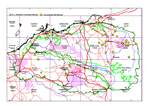Click on images
to enlarge


, BRM 5273, ORIGINAL SCAN, ADJUSTED RICHARD WOODMAN_sml.jpg)
Photographer: B.R. Maslin

Photographer: K. Newbey

Photographer: M.W. McDonald

Photographer: M.W. McDonald

Photographer: B.R. Maslin

Photographer: B.R. Maslin

Immature pods. Photographer: B.R. Maslin

Photographer: J. Maslin
, BRM 8656, lab photo by Fiona McCallum ADJUSTED_sml.jpg)
Seed from one herbarium voucher. Scale in mm. Photographer: F. McCallum.
Botanical name
Acacia ptychophylla F. Muell., J. Proc. Linn. Soc., Bot. 3: 142 (1859)
Description
Low, dense, flat-topped or somewhat rounded, glabrous shrubs usually 0.5-1 (-1.5) m tall and spreading 0.5-2 m across, much-branched at base. Bark light grey, slightly roughened at base of main stems, otherwise smooth. Branchlets resin-ribbed, reddish brown but yellow or light green at extremities. Phyllodes narrowly oblong-elliptic, 2-4 (-5.5) cm long, 4-10 mm wide, rather leathery, ascending to erect, straight or sometimes shallowly incurved, not shiny, green but aging greyish green to sub-glaucous; with 5-6 (-8) uniformly prominent, well-spaced, longitudinal nerves which appear raised due to being encrusted with a thick layer of resin, rarely a few obscure, oblique, minor nerves between main nerves; apical callose point thick and gland -like. Glands one tiny, situated on upper margin of phyllode near base with 1-3 additional, variably spaced glands higher up. Inflorescences simple, held above the phyllodes like candles; peduncles 15-30 mm long; spikes fragrant, large, (25-) 30-45 mm long, bright golden, dense, erect but drooping and persisting on plants for some time following anthesis with the flowers ultimately turning brown. Flowers 5 merous; calyx dissected to about ½-2/3 its length. Pods narrowly oblong to oblong-elliptic but narrowed towards the base, flat, to 7 cm long, 6-8 mm wide, erect, firmly crustaceous to woody, opening elastically and explosively from the apex (the valves strongly recurved following dehiscence), some pods persisting on plants for a long time, straight or shallowly curved, marked with prominent, obliquely longitudinal nerves, reddish brown or light greyish brown but encrusted with a resin which obscures the underlying colour, hooked at apex. Seeds obliquely placed in pods and seated in distinct yet shallow chambers, obloid-ellipsoid, 4-5 (-5.5) mm long, (slightly) shiny, very dark brown; pleurogram bordered by a narrow band of dull yellow tissue; funicle-aril turbinate, straight, white (drying pale dull yellow) except greenish near attachment to seed.
Characteristic features
Low, spreading, flat-topped or somewhat rounded, glabrous shrubs. Branchlets resin-ribbed, reddish brown but yellow or light green at extremities. Phyllodes rather short, narrowly oblong-elliptic, terminated by a very short hard point, ascending to erect, with 5-6 (-8) rather prominent longitudinal nerves which appear raised being encrusted by resin. Spikes long, held above the phyllodes (like candles) on long peduncles; bright golden. Pods narrowed towards the base, erect, flat, woody, encrusted with resin, obliquely longitudinally nerved. Seeds with a terminal, straight, turbinate funicle-aril.
Distribution and ecology
Of scattered occurrence with a disjunct distribution in northern Australia; it occurs in the Pilbara and south-eastern Kimberley regions of Western Australia and extends just into Northern Territory where it occurs in the Hooker Creek area. Within the Pilbara A. ptychophylla has a scattered distribution where it extends from near Panawonica, Tom Price and Newman to east of Marble Bar; most collections are from the northeast of the region. Although it is not a dominant plant of the Pilbara landscape A. ptychophylla is often common in the relatively localized populations that it forms. It grows in gravelly loam or sandy loam, normally associated with low rolling rocky hills and in spinifex (Triodia pungens) communities.
Flowering and fruiting period
Pilbara plants have been collected with at least some flowers present from March to August, however, the main flowering flush is in May and June. Pods with mature seeds have been collected in October.
Variation
A specimen collected from 21 degrees 09 minutes S, 121 degrees 06 minutes E (with other locality details) records this species as growing as a wispy plant 3-4 m tall with few branches. This description is atypical for the species and would need to be confirmed before accepting.
Affinities
Sometimes confused with A. drepanocarpa subsp. latifolia (see that species for discussion).
Notes
An attractive species when in flower and would make a suitable rockery and/or ground cover plant for inland gardens.
Conservation status
Not considered rare or endangered even though it is not especially common.
Origin of name
The botanical name is derived from the Greek ptycho- (a fold) and phyllon (a leaf) and refers to the phyllodes which are characterized by longitudinal nerves that appear raised on account of being encrusted by a thick layer of resin.
